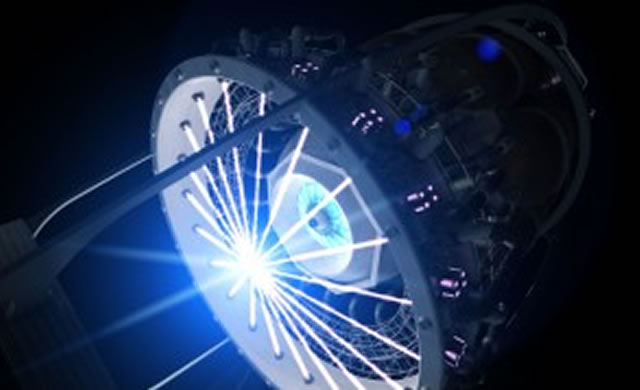
[Image courtesy Adrian Mann]
After charging its lasers using solar energy, the VARIES system fires-up, generating antimatter for the boost phase of an interstellar trek.
The VARIES concept will use powerful lasers to excite a quantum phenomenon, generating antimatter fuel from the vacuum of space.
The energy generated through matter-antimatter annihilation would be ideal for interstellar propulsion. The VARIES concept uses powerful lasers to generate antimatter from the vacuum of space. As the VARIES starship is a return vehicle, it would recharge using solar energy at the target star system.
One possibility for in-situ refueling that we introduce in this proposal is a quantum effect known as Schwinger pair production. At all energies probed by experiments to date, the universe is accurately described as a set of quantum fields. Each mode of the vacuum behaves like a simple harmonic oscillator, and one quantum mechanical property of these oscillators is that their ground state exhibits fluctuations as a consequence of the Heisenberg Uncertainty Principle. The vacuum is thus not devoid of matter or energy as classical physics would have us believe, but is instead a rich arena of quantum activity. Not long after Dirac’s discovery that a relativistic description of electrons required the existence of positrons it was realized by Nobel Prize winning Physicist Julian Schwinger that that a strong enough electric field can create electron-positron pairs out of the vacuum of space itself.
Source/Continue reading → news.discovery.com
Utilizzare laser ed antimateria per viaggiare tra le stelle – Il concetto di varies userà potenti laser per eccitare un fenomeno quantistico, che genera combustibile di antimateria dal vuoto dello spazio.
Mentre i viaggi interstellari sono stati esplorati dai ricercatori, un tipo di missione non ha ricevuto molta attenzione, vale a dire l’appuntamento interstellare e la missione di recupero che potrebbe essere realizzata su scale temporali comparabili con la carriera di uno scienziato che lavora.
Poiché l’antimateria offre la densità di energia più alta possibile al momento di annientare la sua controparte di materia, è ideale per le missioni interstellari. Inoltre, la reazione avviene spontaneamente e quindi non richiede complessi sistemi di reattori o driver ingombranti per iniziare la reazione. Una possibilità per il rifornimento che presentiamo in questa proposta è un effetto quantistico noto come produzione di coppie Schwinger.In tutti gli esperimenti sodati fino ad oggi, l’universo è accuratamente descritto come un insieme di campi quantistici. Ogni modalità del vuoto si comporta come un oscillatore sinusoidale, e una proprietà meccanica quantistica di questi oscillatori è che il loro stato fondamentale presenta fluttuazioni come conseguenza del principio di indeterminazione. Il vuoto non è quindi privo di materia o energia fisica classica, come vorrebbero farci credere, ma è invece un ambito ricco di attività quantistica. Non molto tempo dopo la scoperta di Dirac che una descrizione relativistica di elettroni necessaria l’esistenza di positroni è stato realizzato dal fisico vincitore del Premio Nobel Julian Schwinger che un forte campo elettrico è in grado di creare coppie di elettrone-positrone dal vuoto dello spazio stesso.
Fonte/Leggi tutto → pianetablunews.wordpress.com





















